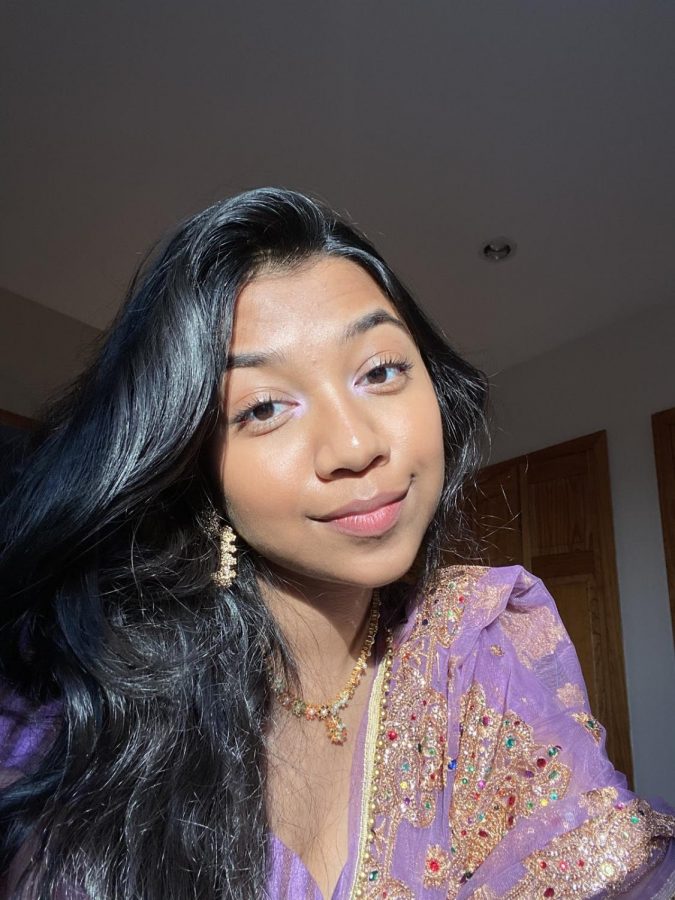A Complex Character: A Review of ‘Never Have I Ever’
While Radia Basher ’21 enjoyed ‘Never Have I Ever’, she did notice that the show would include references to popular South Asians in order to “fit in” with American pop culture.
I will admit, when ‘Never Have I Ever’ first came out on Netflix, I was wary to watch it. I put off watching it for weeks, mostly out of the fear that the show would be another show fulfilling the stereotypes of an Indian-American girl. I had read that the star of the show was named Maitreyi Ramakrishnan, a teenager whose parents are from South India, like me. So, despite what my peers had said about the show, I carried high hopes with me, when I pressed play on my iPad last month.
Initially, I was disappointed with the plot of the show, as it seemed that it was about three teenage girls whose sole goal was to find themselves boyfriends. The trailer that I had watched before starting the series only exacerbated my uneasiness – twenty seconds into it, a young man removed his shirt to seduce the main character. But as the episodes progress, the plot unfolds, and viewers soon realize that ‘Never Have I Ever’ is more than the story of three teenagers looking for love.
Devi Vishwakumar, the protagonist, has been suffering from grief the past year of her life. Her father passed away after a heart attack he had suffered from at a school function. In the months following his death, Devi’s lower body became paralyzed. Through the scenes between Devi and her therapist, played by actress Niecy Nash, we come to understand that Devi’s obsession with finding a boyfriend stems from her disinclination to deal with her lingering grief.
Though Devi has had her fair share of difficulties, she remains a vibrant and vivacious character. She is not afraid to approach the boy she likes, nor hesitant to argue with the boy she does not like at a Model UN conference. But Devi is also a flawed character, who sometimes lashes out at her adamant mother and distances herself from her friends. Although these flaws make her less “likeable” to many people with whom I have discussed the show, I applaud Mindy Kaling, the show’s producer, for making this bold decision.
Oftentimes in television shows, people of color are not fully developed characters, and simply appear so that the show’s producer can declare that they have a diverse cast. Devi does not fit into this trope, and she stands out as a complex character. She is a young woman struggling with the trauma on her shoulders but remains bold and confident, which is demonstrated through each of her actions. Kaling takes the plunge and shows both the pleasant and unpleasant side of the protagonist, which is a move that many producers do not take with female characters — especially female characters of color.
However, the primary reason that I enjoyed this show was that I connected with the main character. Her experiences as a South Indian -American, while not identical, are similar to mine. Devi’s father is redolent of my father, a man who always places confidence in me and tells me to “fight back with [my] spirit,” as Devi is told by her father in the pilot. Her parents speak in Tamil, the same language that my parents speak to me. Her mother calls her kanna, a word similar to sweetheart, and a word that my mother calls me. Devi and her family eat dosa and sambar, dishes that are popular in South India — and in my household — but are not represented in the media. Before watching this series, I had not realized how much representation of my culture in a popular Netflix show would mean to me.
Of course, every teenage television drama has its flaws. While ‘Never Have I Ever’ did mostly stray away from South Asian stereotypes, there were some allusions that my peers and I found to be disagreeable. Radia Basher ’21 noted, “While I do love the South Asian representation that we get in the new Netflix Original, ‘Never Have I Ever’, I feel as though it’s more of a show catered to non-desis instead of South Asians. With references to Priyanka Chopra, one of the only Bollywood stars that Western media is familiar with, I believe the show focused on fitting in more than appreciating desi culture.” Like Basher, I noticed that some parts of the show specifically appealed to white audiences. The series, while starring a woman of color, is narrated by tennis player John McEnroe. While the show constantly reminds us that there is a connection between him and the protagonist, it seemed to me as if the producers believed that they needed to place a white male on the center stage in order to legitimize the series.
Despite its flaws, ‘Never Have I Ever’ provided insight into the life of an Indian -American teenager, without attempting to generalize her experiences. Devi Vishwakumar is a girl who I may relate to, but who is also not an abstract archetype that is supposed to vaguely represent every South Asian girl in America. I enjoyed watching a show about imperfect women of color make their way through adolescence, and I am excited to see what they have in store for viewers next season.
To watch ‘Never Have I Ever’ on NetFlix (subscription required), click HERE.
Kaling takes the plunge and shows both the pleasant and unpleasant side of the protagonist, which is a move that many producers do not take with female characters — especially female characters of color.
Lavanya Manickam is an Editor-in-Chief for ‘The Science Survey.’ She enjoys writing narratives that provide insight into various perspectives, and...

